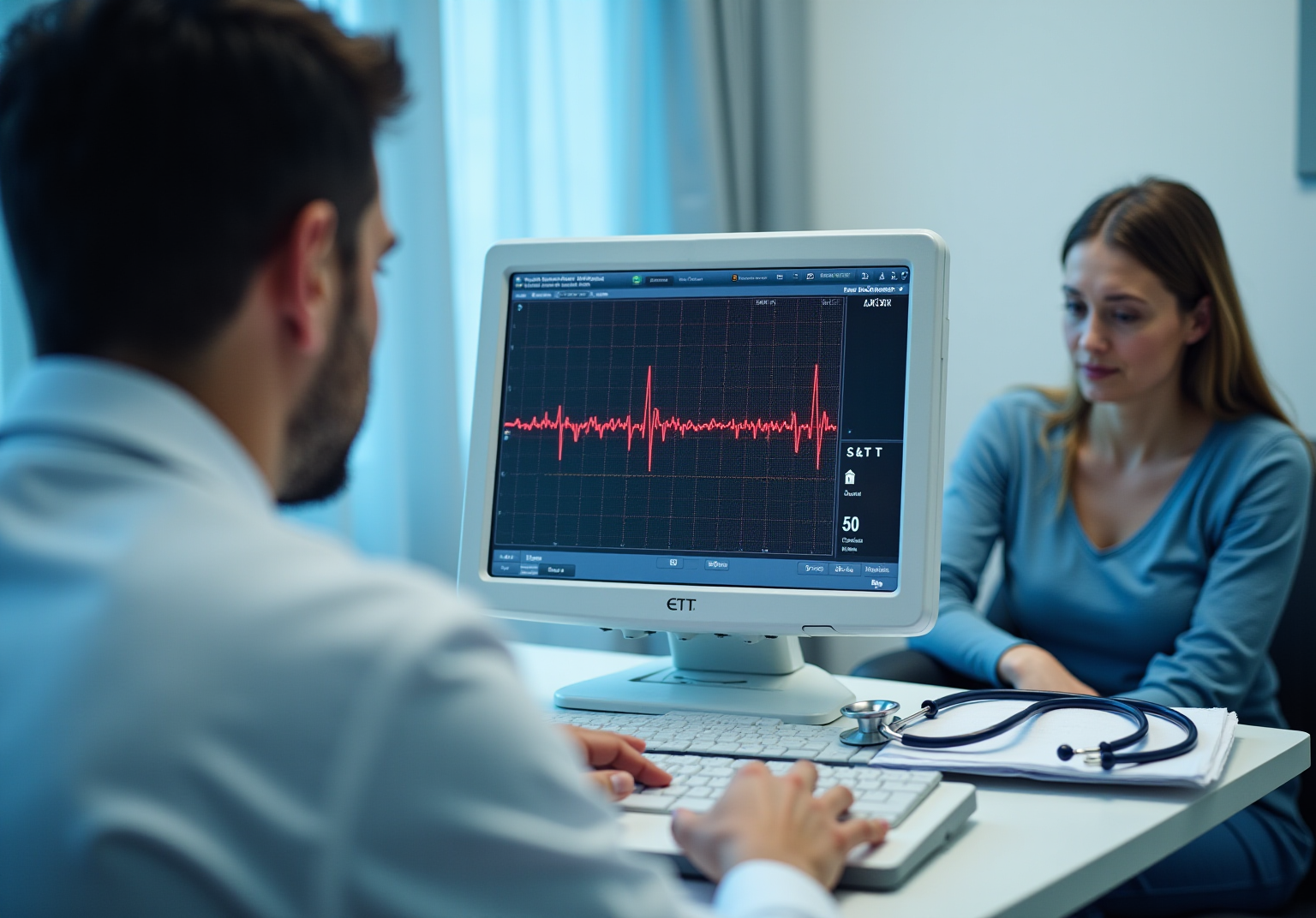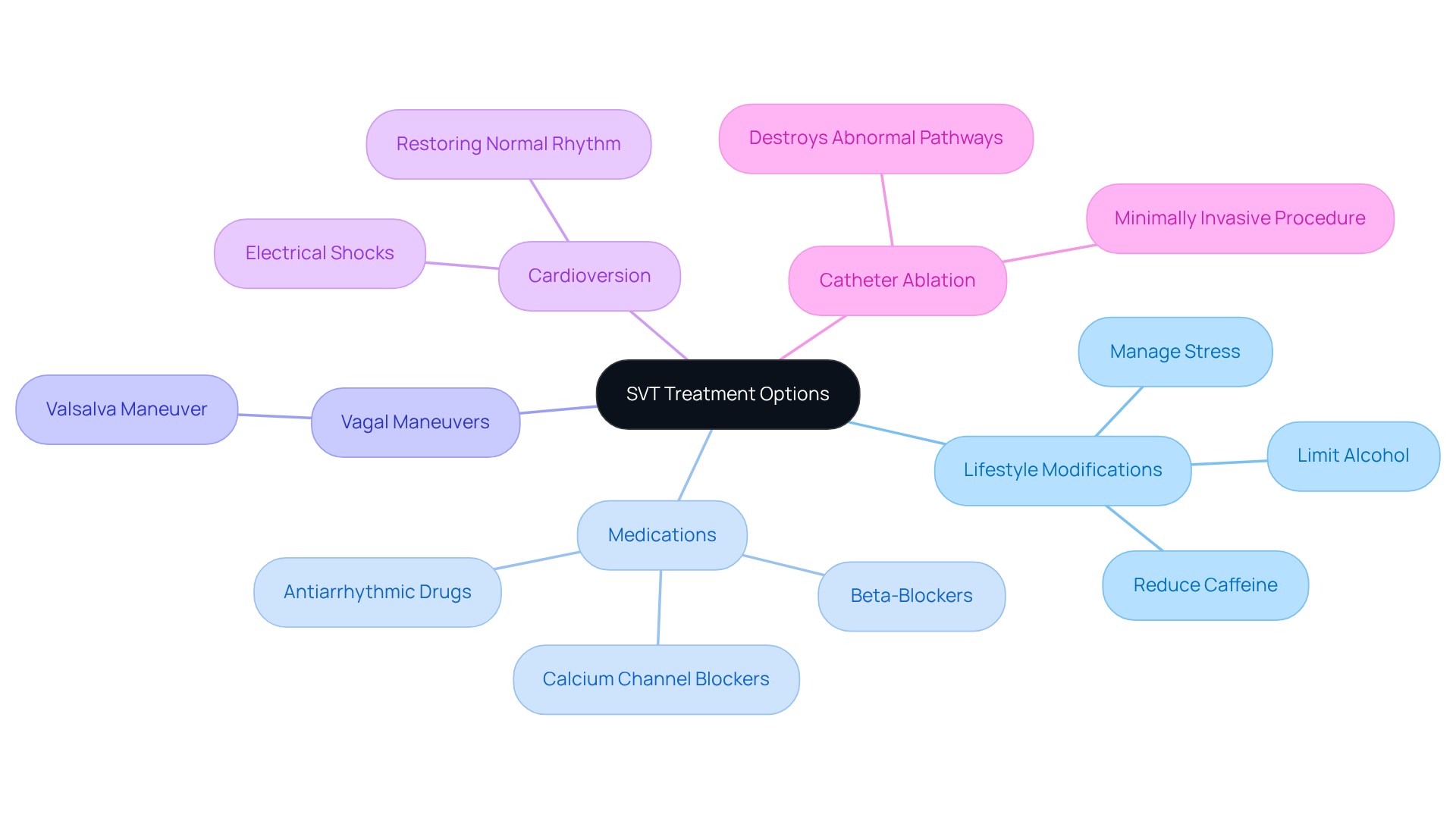


Supraventricular Tachycardia (SVT) can be concerning, as it is characterized by a rapid heart rate originating above the ventricles. Many individuals experience symptoms such as:
If you're feeling this way, know that you're not alone. Diagnosing SVT typically involves tests like ECGs and Holter monitors, which can help clarify your condition.
Understanding the different types of SVT, along with their symptoms, is crucial for managing this condition effectively. There are various treatment options available, including:
Each of these can play a significant role in enhancing your well-being and quality of life.
It's important to remember that support is available. If you have concerns about SVT or your heart health, please reach out to a healthcare professional. They can provide guidance tailored to your needs, ensuring that you feel cared for and informed every step of the way. Your health matters, and taking action is the first step towards feeling better.
Understanding heart health can often feel overwhelming, particularly when it comes to conditions like Supraventricular Tachycardia (SVT). This group of rhythm disorders is characterized by a rapid heartbeat that can exceed 100 beats per minute, presenting unique challenges and symptoms that may disrupt daily life.
By exploring the different types of SVT, their symptoms, and the latest diagnostic and treatment options, you can gain valuable insights into effectively managing your heart health. But with so many approaches available, how can you find the most suitable path for your specific needs?
Rest assured, you are not alone in this journey.
Supraventricular Tachycardia (SVT) encompasses a range of rhythm disorders that begin above the ventricles. It is characterized by a rapid pulse, often exceeding 100 beats per minute, which can be concerning. Understanding the different types of SVT heart rate is crucial for recognizing symptoms such as palpitations, dizziness, or fatigue, and for determining the appropriate care options.
There are several types of SVT:
At Amavita Heart and Vascular Health, we understand that navigating these conditions can be overwhelming. Our comprehensive arrhythmia management program utilizes advanced monitoring technology to identify the specific type of svt heart rate you may have. We are dedicated to providing that ensure your comfort and well-being.
Our outpatient approach is designed to minimize disruption to your daily life while effectively managing your cardiovascular health. We aim to enhance the quality of life for our elderly patients, ensuring that you feel supported and cared for every step of the way. If you have concerns about your heart health, please don’t hesitate to reach out for assistance—we are here to help you.

Symptoms of SVT can vary, but common signs to be aware of include:
At Amavita Heart and Vascular Health®, we understand how worrying these symptoms can be. Early detection is crucial, and we are here to support you. Our cutting-edge AI-driven diagnostic technology, part of the CardioElite™ program, offers real-time guidance and quick reporting on cardiovascular structure and function. This ensures that individuals at high risk receive prompt medical evaluation and management. By addressing these concerns early, we can significantly reduce the likelihood of complications associated with svt heart rate, providing you with peace of mind and the care you deserve. Remember, you are not alone in this journey; we are here to help you every step of the way.

Diagnosing the SVT heart rate can be a concern for many, and it typically involves several important procedures that help ensure your heart health is thoroughly assessed.
These diagnostic instruments are essential for verifying the SVT heart rate and guiding treatment choices. At this facility, we strive to integrate them into a seamless care process, enhancing your outcomes and reducing the likelihood of hospital readmissions. Remember, you are not alone in this journey; we are here to support you every step of the way.

At Amavita Heart and Vascular Health, we understand that managing svt heart rate can be a source of concern for many patients. Our treatment options are designed with your well-being in mind, and we are here to support you every step of the way.
Each treatment plan at Amavita is comprehensive, taking into account your age, health status, and the specific type of svt heart rate condition you may have. We ensure that high-risk patients receive the targeted cardiovascular care they need, and we are dedicated to walking alongside you on your journey to better health. Remember, you are not alone in this—our is here to support you.

Understanding Supraventricular Tachycardia (SVT) is crucial for recognizing its symptoms, diagnosing the condition, and exploring effective treatment options. This article has provided a comprehensive overview of SVT, detailing its types, symptoms, diagnostic procedures, and management strategies. By familiarizing yourself with these aspects, you can better navigate your heart health and seek timely medical intervention when necessary.
Key insights discussed include the various types of SVT, such as:
Along with common symptoms that may signal the presence of this condition, including:
The diagnostic procedures, ranging from:
Serve as crucial tools in accurately identifying the specific type of SVT and tailoring appropriate treatment plans. Furthermore, treatment options encompass:
All designed to improve patient outcomes and enhance quality of life.
Ultimately, being aware of and proactively managing SVT can significantly enhance your cardiovascular health. If you are experiencing concerning symptoms, please do not hesitate to seek medical advice and utilize available resources for diagnosis and treatment. By taking these steps, you can ensure a more informed approach to managing SVT and maintaining your overall heart health.
What is Supraventricular Tachycardia (SVT)?
Supraventricular Tachycardia (SVT) refers to a range of rhythm disorders that begin above the ventricles and are characterized by a rapid pulse, often exceeding 100 beats per minute.
What are the symptoms of SVT?
Symptoms of SVT can include palpitations, dizziness, and fatigue.
What are the different types of SVT?
The different types of SVT include:
How does Amavita Heart and Vascular Health assist patients with SVT?
Amavita Heart and Vascular Health offers a comprehensive arrhythmia management program that utilizes advanced monitoring technology to identify the specific type of SVT. They provide innovative, minimally invasive treatments to ensure patient comfort and well-being.
What is the approach of Amavita Heart and Vascular Health towards patient care?
Their outpatient approach is designed to minimize disruption to daily life while effectively managing cardiovascular health, aiming to enhance the quality of life for patients, particularly the elderly.